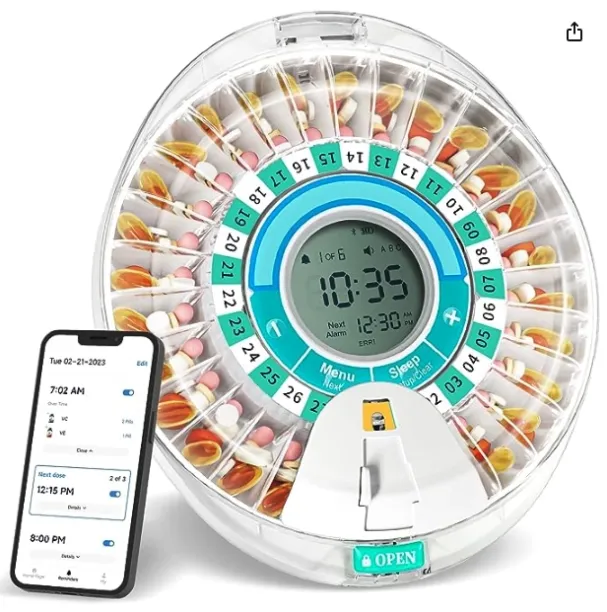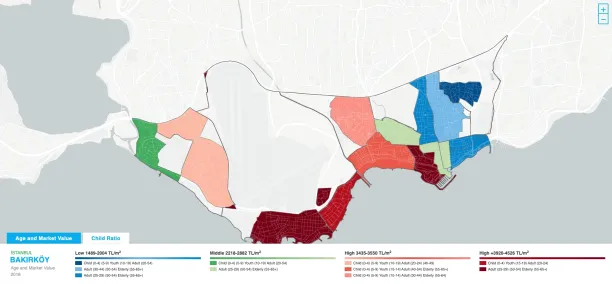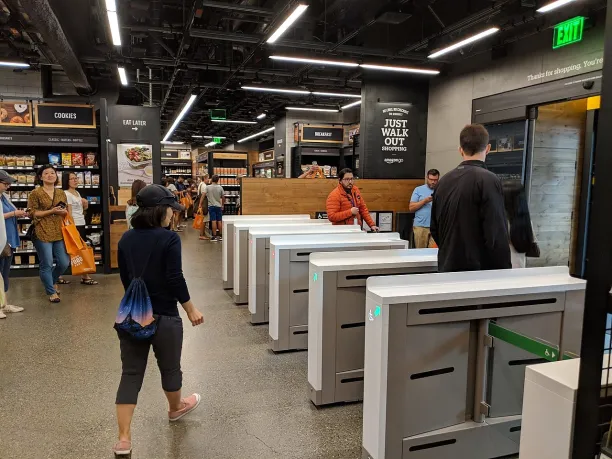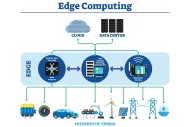Internet of Everything (IoE) in 2024: 15 Use Cases
Internet of Everything (IoE) is the idea that things, data, people, and processes can be interconnected via sensors and communication protocols. This paradigm shifts the narrative from mere device connectivity to a more holistic integration of everything in our surrounding.
In this ecosystem, your coffee mug notifies you when your beverage reaches your preferred temperature, or your refrigerator orders groceries based on your consumption patterns.
This article explains the intricacies of IoE, exploring its four pillars —things, data, people, and processes— and examining how they interact to create an intelligent, interconnected ecosystem that promises to make our lives more efficient, sustainable, and interconnected.
What is the Internet of Everything (IoE)?
Internet of Everything (IoE) is the connection of people, processes, data, and things.
In the Internet of Everything framework, a coffee mug has an embedded technology connecting it to the Internet. For example, a temperature sensor tracks the heat level of the liquid inside; a weight sensor measures the liquid amount. This data – often referred to as big data in larger IoT ecosystems that don’t come from one or two but thousands of sensors – is then transmitted to a cloud computing platform, via IoT communication protocols, for analytics and processing.
On the human side, the person gets a smartphone notification telling them their coffee is now at their preferred temperature.The cup “knows” the drinker’s preferred temperature not because it was entered manually, but because the cup’s been “observing” and “learning” the temperature at which it’s been getting drunk.
Moreover, if the individual usually listens to an audiobook whilst drinking their coffee, the moment the first sip is taken, the cup would exchange this data with the smart speaker on the coffee table. The speaker would automatically turn on and resume playing the audio book.
This scenario encapsulates the utopian idea of IoE at a small scale, where the user is involved in intuitive interactions with their surroundings with minimal effort.
What are the four pillars of Internet of Everything (IoE)?
People, processes, data, and things are the 4 pillars of IoE:
- Things: All physical objects are equipped with sensors and actuators that collect and transmit data.
- Data: This is the massive amount of raw data generated by the smart devices. This data, when processed, provides the intelligence used for data-driven decision making.
- Processes: These are the backend systems, the algorithms, and the network intelligence that make sense of the data.
- People: To receive the produced insights, humans would be connected to the Internet either invasively – with an embedded chip, like Elon Musk’s neuralink – or non-invasively – by carrying a wearable or portable technology, like a smartphone.
What is the difference between IoT and IoE?
IoT and IoE differ on focus scope, components, data flow, analysis, and use cases.
Internet of Things (IoT)
- Focus scope: Machine to machine interaction for rule-based task execution
- Components: Things, Data, Processes
- Data traffic flow: Unidirectional, from IoT devices to a cloud computing system
- Analysis: Limited to device performance and monitoring
- Use cases: Specific use cases like smart homes, industrial settings, healthcare, smart cities, etc.
Going back to our coffee mug example, in the context of IoT, the user would manually input the desired temperature level, and once the liquid reaches it, the cup would send a notification to the user’s smartphone informing them as such, and that’s where the interaction ends.
Internet of Everything (IoE)
- Focus: Intelligent, fluid, and intuitive interaction within distributed systems
- Components: Things, Data, Processes, People
- Data traffic flow: In multiple directions, between internet connected devices, to and from humans, and between different processes
- Analysis: Involves advanced artificial intelligence techniques, like machine learning (ML), to predict future events, learn from data, and adapt to changing conditions
- Use cases: Broad use cases involving intelligent connection of multiple disparate systems
What are some use cases of the Internet of Everything (IoE)?
We have listed current and futuristically possible use cases of IoE below.
Healthcare
1. Smart apparel
Nike’s self-lacing shoe captures the wearer’s blood pressure through embedded sensors in the shoe. It then automatically loosens/tightens the shoe accordingly.
2. Health monitors
Patients can wear wearable monitors to track their sugar levels, for instance, and connect it to a smart pill dispenser (Figure 1). The dispenser itself is connected to the patient’s Electronic Health Records (EHR), which houses their prescription details. Whenever the patient’s sugar level falls below a certain threshold, the monitor alerts the pill dispenser to dispense the relevant dosage, and sends a notification to the patient to their pill.

Figure 1: An Internet-connected pill dispenser. Image source: Amazon
3. Telehealth
For those wanting to lose/gain weight, smart refrigerators leveraging sensors, cameras, and RFID (Radio Frequency Identification) technology can send a transcribed list of all the foods stored in them to the cloud, accessible by a dietician. The dietician could then curate a personalized dietary plan, point out and do and don’ts in their current food inventory, and monitor their daily consumptions.
Explore IoT in healthcare in more detail.
Smart cities
4. Water management
Tel-Aviv’s municipality equipped water pipes with Cisco’s smart-water camera chips1. By transmitting data from underground pipes to the Cloud, the supervisory control center was able to monitor leaks, drains, water levels, and water pressure. With the generated data from these pipes, Israel hopes to reduce costs, prevent water shortages, and moderate water consumption.
5. Smart traffic management
By connecting the physical devices such as street cameras, smart traffic lights, and the GPS-connected vehicles, and analyzing the generated data, traffic congestion can more efficiently be managed. For example, during rush hours, algorithms would process this data in real-time to dynamically adjust traffic light timings. Or navigational applications would provide alternate routing suggestions to disperse the traffic.
6. Urban planning
In Istanbul, the municipality is using live satellite images and camera pictures, in addition to traditional population datasets, to build2 more daycares and parks districts with the highest number of children and the elderly present (Figure 2).

Figure 2: An Istanbul’s districts children population density. Image source: Kent95
Retail
7. Automated check outs
Amazon Go has automated checkouts. When users enter the store, they are automatically logged into their Amazon account. And each item they pick off a shelf is automatically added to their virtual cart. And once they leave the store, the total receipt amount is deducted from their card they’ve saved on Amazon’s system (Figure 3).

Figure 3: Shoppers seamlessly checking out by walking out the door. Image source: Wikipedia
8. Restocking shelves
Shelves that are equipped with RFID tags monitor the items on each row. Whenever an item is picked off the shelves, one is automatically deducted from the total number of that item in the inventory management software. When the quantity falls below a certain level, the software notifies the staff so they can restock the shelves before they are empty.
9. Supply chain management
Sensors and GPS on delivery vehicles and products allow for real-time tracking, ensuring that products arrive on time and in the right condition, thereby streamlining the supply chain. Especially for companies that are distributors, they can monitor the ETA of products and exchange data in real-time with the retailers.
Explore IoT in retail in more detail.
Smart homes
10. Security systems
In homes with smart lights, cameras, and sensors, security systems could automatically be engaged when there’s no sign that anyone is inside the house. This is particularly useful when people go on vacations and forget to lock their doors. Moreover, these systems can send real-time alerts to owner’s phone and enable remote controlling.
11. Energy management
Smart thermostats can learn from your behavior and adjust the temperature accordingly, whilst allowing remote controlling on mobile devices. Other technologies, such as smart lights or irrigation sensors, can also monitor their environment and learn from your usage patterns. For example, for conservation reasons, you might only water your lawn once a week. The sensors would learn to automatically turn on without you having to program anything manually.
12. Entertainment systems
Smart TVs, sound systems, and other entertainment devices can be controllable and adaptable to to user preferences over time. For example, the TV could learn to turn on when the user comes home at 5PM everyday, and unlocks the door. Or on weekends, jazz music can start playing in the mornings if the user has passively (i.e., without programming a schedule in it) trained it to do so.
Industrial processes
13. Predictive maintenance
Sensors placed on pieces of machinery and equipment can monitor their temperature, vibration levels, speed, and operational time to generate data to preemptively notify the maintenance and engineering department when a maintenance is needed. This would happen before the machine goes into breakdown, thus reducing repair downtime and extending the useful life of the machine.
In addition, the IoT data from one connected device could be compared with other pieces of equipments’ to constantly carry out facility-wide inspections.
Learn more about predictive maintenance.
14. Quality control
Data from multiple sources such as sensors on the production line, quality check systems, employee feedback, and even customer reviews can be aggregated and analyzed collectively. This data-driven approach provides a multi-faceted view of quality.
For example, let’s say a phone manufacturer’s phone batteries keep catching fire. The company can aggregate all mentions of battery issues on social media to understand how and in which settings the fires are breaking out. The data could then be used to lower the alert threshold of sensors on factors such as, temperature, voltage and current, electrolyte leakage, etc. Then the serial numbers of new production batches can be tracked to see if the issue keeps happening.
15. Workers’ health and safety
Workers can wear smart watches that monitor their vital signs, such as body temperature, even levels of exposure to harmful materials. If a sensor detects abnormal levels of, say, heart rate, it can alert the worker and the safety manager. Training modules or production schedules can then be dynamically updated, to teach the worker how they can lower their heart rates (by learning relaxation techniques) and manage the workload to avoid strenuous production timelines.
Learn more about Industrial IoT.
What are IoE’s challenges?
- Security: This is, arguably, an unsolvable challenge of IoE. As long as there are data stored in the Cloud, there is the threat of cybersecurity. For example, if a household uses a smart-lock for entry and exit, and hackers hijack the application, then they could, theoretically, lock the family out of their own house. This is just one example. Imagine a power plant’s software being hijacked, or a self-driving Tesla, with a passenger inside, driving to the unknown.
- Privacy: Interconnected to security, privacy is another main challenge facing IoE. Consider smartwatches, for instance. They are already capable of predicting a heart attack based on the recognition of vital signs. If a health insurance company, through your smartwatch, accesses your medical data, they will be able to blindly discriminate against you in the shape of costly blanket policies.
- Compatibility: The number of IoT devices is on the rise. There are thousands of different programmers creating more devices and software each year, using different methods, codes, and standards. Connecting all these devices into a harmonious ecosystem can require more oversight, larger IT expenditures, and longer downtime in case of repairs. The good news is the existence of composable applications. Composable application (CA) is the idea of using app builders to estimate what the most useful blocks are among multiple complete applications and then “compose” these blocks into a new application. This helps streamline the integration process.
Further reading
We have the following articles written on the IoT:
- Capture More IoT Market Share
- IoT-5G For a Fast and Consistent Connectivity
- Edge Computing: A Better Alternative Than Cloud for IoT
And if you believe your business will benefit from an IoT or IoE solution, feel free to check our data-driven hub of IoT solutions and tools.
And let us guide you find the right vendor:
This article was originally written by former AIMultiple industry analyst Bardia Eshghi and reviewed by Cem Dilmegani.
Sources
- 1. “Israeli firms co-develop unique water monitoring system.” Smart Energy International. November 19, 2019. Retrieved on August 28, 2023.
- 2. “Istanbul Wants to Make Urban Data Available to Everybody.” Bloomberg. June 5, 2023. Retrieved on August 28, 2023.

Cem has been the principal analyst at AIMultiple since 2017. AIMultiple informs hundreds of thousands of businesses (as per similarWeb) including 60% of Fortune 500 every month.
Cem's work has been cited by leading global publications including Business Insider, Forbes, Washington Post, global firms like Deloitte, HPE, NGOs like World Economic Forum and supranational organizations like European Commission. You can see more reputable companies and media that referenced AIMultiple.
Throughout his career, Cem served as a tech consultant, tech buyer and tech entrepreneur. He advised businesses on their enterprise software, automation, cloud, AI / ML and other technology related decisions at McKinsey & Company and Altman Solon for more than a decade. He also published a McKinsey report on digitalization.
He led technology strategy and procurement of a telco while reporting to the CEO. He has also led commercial growth of deep tech company Hypatos that reached a 7 digit annual recurring revenue and a 9 digit valuation from 0 within 2 years. Cem's work in Hypatos was covered by leading technology publications like TechCrunch and Business Insider.
Cem regularly speaks at international technology conferences. He graduated from Bogazici University as a computer engineer and holds an MBA from Columbia Business School.
To stay up-to-date on B2B tech & accelerate your enterprise:
Follow on

Comments
Your email address will not be published. All fields are required.